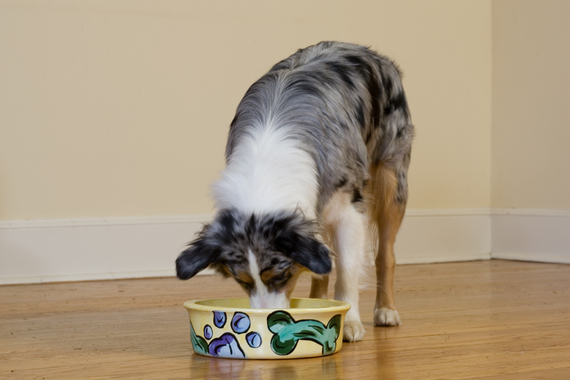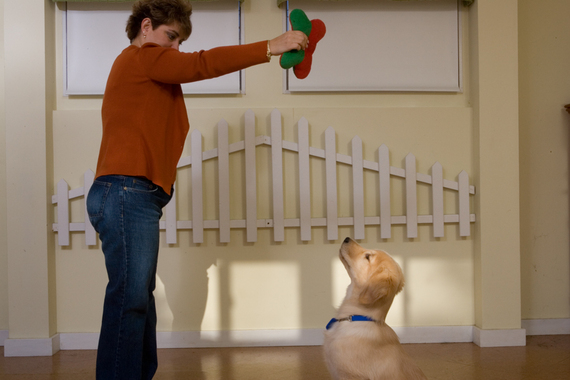Want to feel good about training your dog? Here are my top three tips.
#1 -- Don't make your dog wait to eat.
#2 -- Never stare at your dog.
#3 -- Do not correct a young puppy for chewing or nipping. You read right. No fingers down the throat, pinning of the jaw, neck shaking or crating for punishment.
These statements may run contrary to everything you've heard about training a dog.
Let me expand.
About Mealtimes
As a trainer, I'm always impressed and amused when a client tells me they can get their dog to wait for their supper.
Comment A -- "I put his dinner bowl on the ground, and he'll wait for an hour until I say okay!"
Comment B -- "I can walk across the room, and she won't touch her meal until I release her."
"Bravo!" I say. I have four dogs, and although I'm a dog trainer with some acclaim, I've never considered asking one of them to wait to eat. It seems treason enough that they have to eat the same molded little kibbles day in and day out. Who am I to make them wait?
My philosophy is, if I wouldn't ask it of my kids or I'd be frustrated by the requirement, then why on earth would I ask it of my beloved pet?
Playing devil's advocate, however, here are the arguments for make a dog wait (sometimes indefinitely) for his supper.
It lets him know you're in control.
We humans really do have a thing for control. I'm sure your dog is well aware of your control without you having to hold out on the one predictable, shining moment of his entire day: his dinner. You come and go as you please. You distribute the toys and the food. Dogs work hard to get our attention, well aware of their dependency on the human race. That much I can promise you.
It reinforces your dominance.
Oh puh-lease. Not the "D" word again. Isn't dominance theory sooooo yesterday?
Did you ever read Animal Farm in high school?
If not, let me fill you in. George Orwell published his allegorical tale about the 1912 Russian Revolution, in a fictional fable about pigs who try to outsmart the human race. Pigs -- as in the Old MacDonald-had-a-farm type. It is literature at its finest. The pigs overtake their farmer and envision a world where all animals are treated equally.
Of course, everyone knows that pigs have no interest in ruling the world, right...?
And yet, many people are under the impression that dogs want to rule their home. Pigs taking over the human race; dogs ruling households. In truth, both are a little preposterous on paper, but how many dogs have been pinned to the floor, yelled at and/or beaten in the name of household domination?
Personally, I want my home and my clients' households, to foster peace, love and happiness, not fear or frustration.
Hopefully someone has convinced you that dominating dogs, and using training propaganda to support these impulses, is so, well, so 1980s.
Dogs, who have more in common with pigs than people, are focused on three main things: food, play and interaction. Some are more clever than others, requiring a more structured education, but most just want to know who's dolling out the kibbles and what they can do to get more love, food and attention from them.
The food bowl exercise teaches patience.
Okay, here's a "Well, maybe." But in my opinion, dogs have to practice enough patience just sitting around waiting for us to come home. Why don't you patience-seekers just hold the bowl above your dog's head until they sit down, and call it day? Sweet heavens.
While patience is a good lesson -- an important lesson -- that all dogs should be taught, there are more fun ways to get your point across. Here's a personal favorite, straight out of my Puppies for Dummies book:
-- Take your dog's favorite toy or treat. We'll use a ball in this example.
-- Hold said ball two feet above your dog's head. Stay calm and quiet, and look at the toy (not at your dog).
-- If your dog jumps up, lift the toy straight up. Now it's 3 ½ feet above his head, still out of reach.
-- This may go on for a while. Drop the ball down when your dog is on four paws, and lift it up if he leaps up to get it. Over and over UNTIL your dog sits or stands very calmly.
-- At this point say, "Wait." Count one-one-thousand-two.
-- Then release and/or toss the ball. "Good smart dog!"
-- As your dog catches onto the GAME you can vary "wait" time but not until he thinks it's all part of the fun.
(In this exercise I used a toy. You can also use a treat if your dog is food motivated.)
In summary, while making your dog "wait" to eat isn't going to kill him and sure does look impressive, it's not one of those necessary life lessons like "Get-your-nose-out-of-Aunt-Erma's-crotch," or "Don't-drink-from-the-toilet bowl." Forcing your dog to routinely wait before eating creates a daily ta-do around the food dish that's isn't necessary or nice.
Stay tuned for further explanation on why you should never stare at a dog, or correct a puppy in the days to come. Meanwhile, if you're confused about other issues, such as what to do when a car passes and your dog is determined to bring it down, or how to convinced your dog not to eat the family cat, comment below. There may be a good reason that traditional solutions are not working for you. My motto can be your motto too -- don't dominant, communicate! Let the conversation begin!

